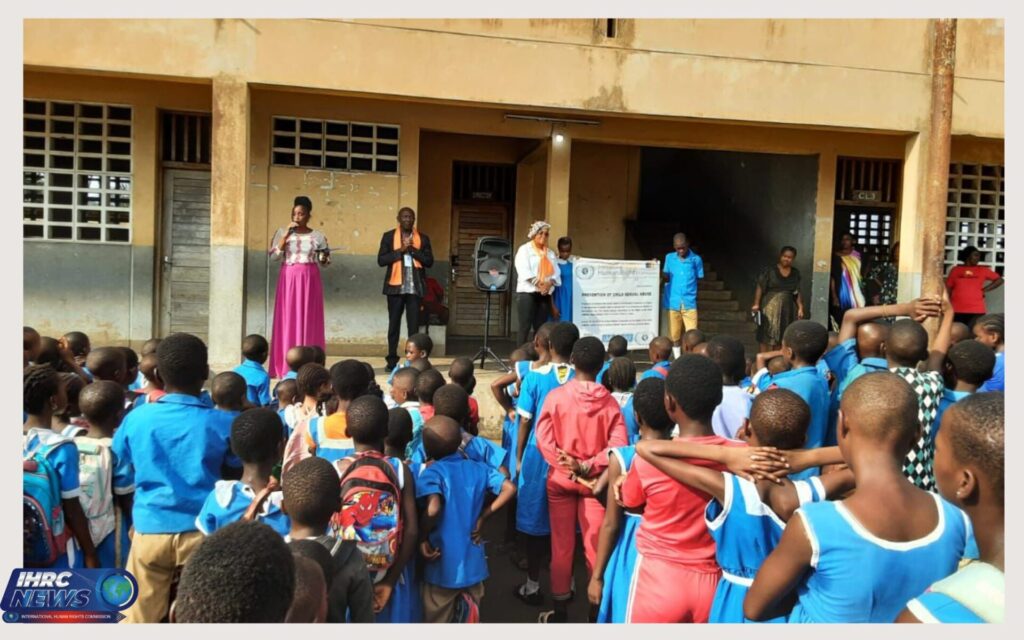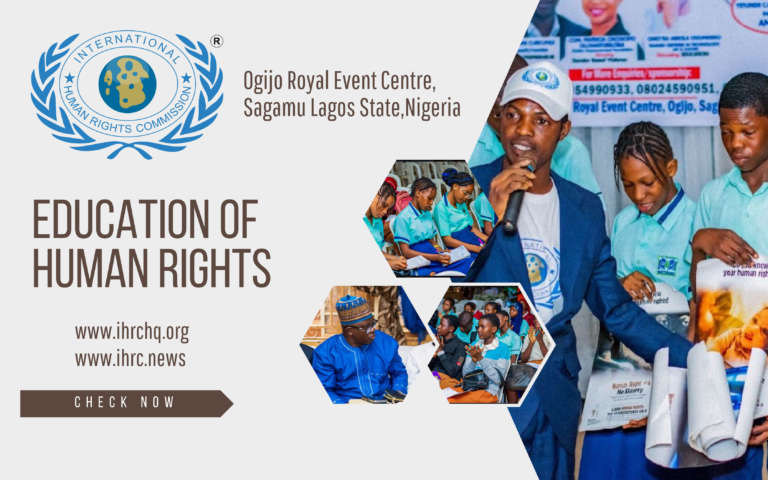Education and Support in Combating Violence: IHRC Tackles Child Sexual Abuse in Cameroon
The International Human Rights Commission -IHRC has made significant strides in addressing critical societal challenges through targeted initiatives. As part of its annual observance of the 16 Days of Activism Against Gender-Based Violence, the IHRC spearheaded a campaign to prevent child sexual abuse, a pressing issue that threatens the safety and well-being of children. This initiative was in alignment with the 2024 UNITE Campaign, themed, “Every 11 Minutes, One Woman is Killed: Unite to End Violence Against Women.” The campaign aimed to highlight the escalating violence against women and girls while addressing its root causes by challenging societal norms and behaviours.
Launched on 25 November 2024, the campaign prioritised educating children and equipping them with the knowledge and skills to prevent sexual abuse. Over 5,000 children in the South West Region of Cameroon were reached, with efforts deliberately inclusive of children from diverse socio-economic backgrounds. The strategy focused on fostering trust, educating about body ownership, recognising safe and unsafe touches, and encouraging children to voice concerns about abuse.
A core component of the campaign was the creation of an environment of trust and open communication, enabling children to freely share their concerns. The IHRC team conducted workshops and interactive sessions designed to facilitate dialogue and understanding. Using simple, age-appropriate language, children were encouraged to express their feelings and experiences. These efforts were extended to parents, carers, and teachers, underscoring the vital role of adults in establishing safe spaces for children.
Central to the initiative was teaching children about body ownership. Through interactive lessons, children were introduced to the concept that their bodies belong to them and that no one has the right to touch them without consent. The “swimsuit rule” served as a practical analogy to help children understand private areas of their bodies. Additionally, children were taught the correct terminology for body parts to ensure clarity and precision in reporting any incidents of abuse.
The campaign also focused on distinguishing between safe and unsafe touches. Through discussions and role-playing exercises, children were encouraged to recognise touches that made them uncomfortable and to assertively say “No” when necessary. They were taught to report any inappropriate behaviour to trusted adults. Practical demonstrations and opportunities to practice these skills in supportive environments reinforced the lessons learnt.
Empowering children with the confidence to recognise warning signs of abuse was a pivotal aspect of the campaign. Children were reassured that abuse is never their fault and were encouraged to identify trusted adults they could approach in unsafe situations. Child-friendly reporting mechanisms were introduced, offering accessible and confidential channels for seeking help.
The campaign also recognised the indispensable role of parents and communities in preventing abuse. Workshops for parents and guardians addressed recognising signs of abuse, fostering open communication at home, and reporting suspicions of abuse. Community leaders were actively engaged to strengthen societal support for the campaign’s objectives.
Despite its successes, the campaign encountered several challenges. Cultural taboos made discussions about sexuality and abuse difficult in some communities. Logistical and financial constraints hindered efforts to reach more remote areas, while stigma and societal silence surrounding abuse posed additional barriers to reporting and intervention.
Nonetheless, the campaign achieved noteworthy milestones. By reaching over 5,000 children, the IHRC empowered many young individuals with the tools to protect themselves. The engagement of parents, teachers, and community leaders reinforced the message and ensured a collective approach to combating child sexual abuse. The distribution of educational materials, including guides and brochures with child-friendly illustrations, further extended the campaign’s impact. Local media coverage amplified awareness, extending the campaign’s reach beyond direct participants.
Looking ahead, IHRC aims to extend the campaign to underserved communities, particularly in rural and remote areas. Strengthening partnerships with local organisations and mobilising additional resources will be crucial to achieving this goal. Sustained community engagement will remain essential to reinforcing the lessons imparted and fostering a culture of openness and vigilance. Enhancing child-friendly reporting mechanisms and advocating for the robust enforcement of child protection laws will also be vital for long-term success.
The campaign to prevent child sexual abuse in the South West Region of Cameroon underscores IHRC’s unwavering commitment to addressing gender-based violence at its roots. By focusing on education and empowerment, this initiative has laid the groundwork for societal change, contributing to a safer environment where children can grow and thrive free from the threat of abuse. Through continued collaboration and effort, IHRC remains steadfast in its mission to create lasting impact in the fight against violence and abuse.





Dr. Holy Anagho
National Volunteers Coordinator, Cameroon
International Human Rights Commission








Very good work for Enhancing child-friendly reporting mechanisms and advocating for the robust enforcement of child protection laws will also be vital for long-term success.
I will appreciate work we’ll done Empowering children with the confidence to recognise warning signs of abuse was a pivotal aspect of the campaign. Children were reassured that abuse is never their fault and were encouraged to identify trusted adults they could approach in unsafe situations.
This campaign by IHRC demonstrates a strong commitment to combating child sexual abuse through education and community involvement. By reaching over 5,000 children and engaging key stakeholders, it has successfully raised awareness and empowered children to protect themselves. The expansion to underserved areas and the continued focus on sustainable community engagement will be crucial for achieving lasting impact in the fight against abuse.
appreciated
I strongly believe that education and support are key in combating child sexual abuse. It’s heartening to see initiatives like IHRC’s that prioritize raising awareness and providing support to victims and their families. Every child deserves a safe and nurturing environment, and it’s our collective responsibility to ensure that. We must continue to work together to prevent child sexual abuse and support those affected by it.
I strongly believe that education and support are key in combating child sexual abuse. It’s heartening to see initiatives like IHRC’s that prioritize raising awareness and providing support to victims and their families. Every child deserves a safe and nurturing environment, and it’s our collective responsibility to ensure that. We must continue to work together to prevent child sexual abuse and support those affected by it.
This is a commendable initiative by the IHRC, addressing a critical issue that affects the most vulnerable members of society—children. By combining education, empowerment, and community involvement, the campaign not only equips children with the knowledge and confidence to protect themselves but also fosters a collective responsibility among parents, teachers, and community leaders. The focus on breaking cultural taboos and encouraging open communication is especially noteworthy, as these are essential steps in combating the stigma surrounding abuse. While challenges like financial constraints and cultural barriers remain, IHRC’s efforts to create lasting societal change and extend the campaign to underserved areas demonstrate a strong commitment to safeguarding the rights and well-being of children. This work sets an inspiring example for other regions to follow.
great work
The IHRC’s campaign demonstrates a commendable effort in addressing child sexual abuse through education and community involvement. Reaching over 5,000 children and engaging key stakeholders highlights its effectiveness in promoting awareness and prevention. Expanding to underserved areas and strengthening partnerships reflects a thoughtful strategy for broader impact. Continued focus on sustainable community engagement and robust child protection mechanisms will be crucial for lasting change.